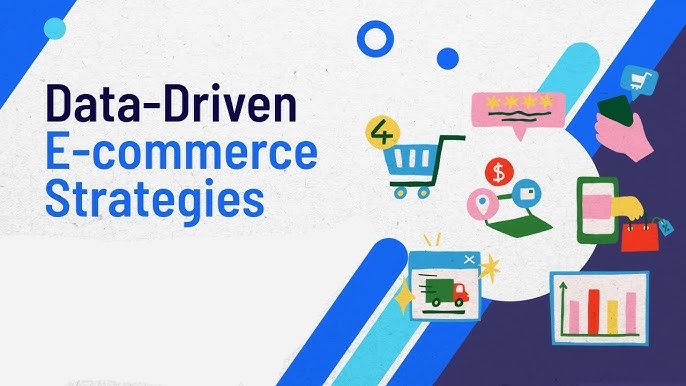In this fiercely competitive digital arena, how do you leverage data to stay afloat or propel your ecommerce business to the next level of success?
Every interaction, click, and purchase leaves behind a digital footprint with loads of insights that can be unlocked and used to inspire customer loyalty, drive sales, and ultimately, help you make the most of your marketing budget allocation.
Data-driven e-commerce is both awesome and intimidating. It looks like something that could make your business millions of dollars in income revenue, but at the same time, no one can explain what it is and how it’s done.

What’s Data-driven Ecommerce?
Data-driven ecommerce is the opposite of operating your ecommerce store in the dark. It’s the opposite of operating your business purely on guesswork or making subjective assumptions, and doing just everything your brain says without making any calculated move.
Data-driven decision making in ecommerce, on the other hand, is about making your ecommerce business decision based on facts and insightful data rather than following your gut feeling.
E-commerce data consists of:
- Customer Behavior: How are customers interacting with your ecommerce store?
- Customer Feedback: What are customers saying about your store and products or services? What decisions do they necessitate?
- Marketing Performance: Which marketing channel drives most sales?
- Sales Trends: What are some of the sales trends you can leverage?
- Product Insights: What are customers saying about your products or services?
After collecting, distilling, processing, and analyzing the data your ecommerce business generates, here are the decisions you can make:
- You can use the data to predict future trends
- You can also use the data to adapt your business practices to customer expectations
- Use the data to tailor their shopping experience
- To increase your return on investment
- To improve your marketing performance and drive sales
- To run an effective marketing campaign
How to Implement Data-driven Ecommerce
The only way to unlock your ecommerce growth is to implement data-driven strategies that cover various aspects of your ecommerce operations.
Here are some key data-driven e-commerce strategies you might want to
consider:
| Strategy | Key Components |
| Customer Segmentation | Targeted Marketing Campaigns
Machine learning Data collection from multiple sources |
| Personalisation | Dynamic Content
Personalized Email Campaigns Product Recommendations |
| Predictive Analysis | Pricing Optimisation
Demand Forecasting Churn Prediction |
| Supply Chain Analysis | Logistics Efficiency
Inventory Management Supplier Management |
| A/B Testing | Results Analysis
Experiment Running Variable Testing |
Customer Segmentation and Targeting

Divide your customers into distinctive groups based on their purchasing behaviors or power, demographics, and preferences.
By understanding each group of customers your business attracts, you can create targeted marketing campaigns that each audience resonates with.
How to Implement Customer Segmentation
- Collect Customer Data: You can start by collecting different customer data from various sources such as social media, website analytics, and customer feedback.
- Analyze the Collected Data: After collecting the data, the next thing you want to do is analyze it. Use machine learning tools such as scikit-learn, NLTK, SpaCy, and H20 ai to analyze this data and sort them into different groups.
- Personalized Marketing: Lastly, you want to personalize your marketing strategy for each segmented group. The goal is to ensure your messaging and offers are relevant to each group’s preferences and purchase needs.
Customer Personalization and User Experience
Personalization isn’t just about mentioning a customer’s name in an email. It’s about understanding the customer and their unique shopping experience based on how they interact with your business.
So, how do you implement ecommerce personalization:
- Product Recommendations: You can use algorithms to recommend products or services to your customers based on how they interact with your store.
- Dynamic Content: You can display different content, such as product listings, banners, based on your customers’ browsing history or profile.
- Personalized Email Campaigns: You can send your customers personalized product recommendations, tailored content, or special offers directly via email.
Predictive Analysis

Predictive analysis is essentially about using historical data to make informed decisions concerning your business or store. It’s how you predict the future based on your customers’ data history.
In ecommerce, predictive analysis can help you with inventory management, demand forecasting, and customer retention.
How to Implement Predictive Analysis to Your Ecommerce Store
Demand Forecasting: The idea is to analyze your past sales and use the data
you collect to predict future sales trends, plan your inventory, and, most importantly, reduce stockouts.
Enhance Supply Chain and Logistics
Data-driven ecommerce makes it easy to optimize your supply chains and logistics.
You can use the data you collect to optimize these processes, reduce costs, and
even improve your inventory delivery times.
Here’s how you implement it:
- Use the data you collect to maintain optimal inventory levels that will ensure your products never run out of stock.
- Use the data you collect to analyze different delivery routes and see which one of them has less traffic or is most cost-effective and timely for you.
- Use the data to monitor and evaluate your suppliers for quality and reliability.
Conclusion
Data-driven ecommerce isn’t just about collecting data, but using the said data to
transform your business through actionable insights.
By understanding how your customers interact with your business, and personalizing their experiences after making informed decisions, you’ll be setting your ecommerce store up for
sustainable growth while gaining an edge in the competitive ecommerce landscape you operate in.

